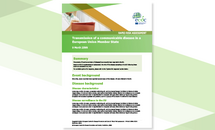Rapid risk assessment: Candida auris outbreak in healthcare facilities in northern Italy, 2019-2021
Italy has reported an outbreak of Candida auris in the region of Liguria with at least 277 cases. The first C. auris case in Liguria was detected in one hospital in July 2019 and cases continued to occur sporadically in the same hospital. In February 2020, C. auris was detected in an intensive care unit (ICU) for treatment of patients with severe COVID-19 in the same hospital, with a subsequent increase in case numbers throughout 2020 and 2021. To date, 277 cases have occurred in at least eight healthcare facilities in Liguria, and 11 cases in facilities in the neighbouring region of Emilia-Romagna.
Executive summary
Main conclusions and options for response
C. auris poses a risk for patients in healthcare facilities across the European Union/European Economic Area (EU/EEA) due to its ability to cause infections in critically ill patients and its resistance to several antifungal agents, which makes infections difficult to treat. Patients hospitalised with severe COVID-19 are at risk of healthcare-associated infections, including candidaemia, and various outbreaks of C. auris among COVID-19 patients have been reported worldwide.
Given the high number of cases, the spread of C. auris to various healthcare facilities in Liguria and interregional spread to Emilia-Romagna, and the difficulty to contain the outbreak (which has been ongoing for more than two years, with the last cases occurring in October 2021 in Liguria and in December 2021 in Emilia-Romagna), the risk of further spread within Italy is considered to be HIGH. As local and national control measures are being implemented, the risk of introduction of C. auris into other EU/EEA countries from this specific outbreak in northern Italy remains LOW unless hospitalised patients are transferred from this region. However, given the worldwide spread of C. auris and related previous detection of sporadic cases and outbreaks in the EU/EEA, it is likely that more undetected cases will eventually enter the EU/EEA from regions with less capacity for C. auris surveillance and control, and therefore continued vigilance is needed.
It is therefore of high importance that EU/EEA countries have adequate laboratory capacity and national surveillance in place to detect C. auris cases early and immediately implement control measures such as alerts to healthcare staff, screening for carriage, contact tracing and enhanced infection prevention and control measures. Control will be more difficult to achieve once C. auris dissemination has reached the level of interfacility and interregional spread. Local control of C. auris as soon as possible after introduction to delay the establishment of C. auris in a country’s healthcare facilities will have a nationwide benefit by reducing future healthcare-associated infections with C. auris. For this reason, national and regional public health authorities should follow-up and offer advice and support to healthcare facilities for all detected C. auris cases to make sure adequate measures are implemented, including screening to detect underrecognised transmission, where appropriate. Cases of C. auris and multidrug-resistant organisms occurring in units for COVID-19 patients should trigger a review of procedures with the aim of ensuring the ability of staff to adhere to standard and contact precautions. Detailed control measures are outlined in the ‘Options for control’ section of this risk assessment.






